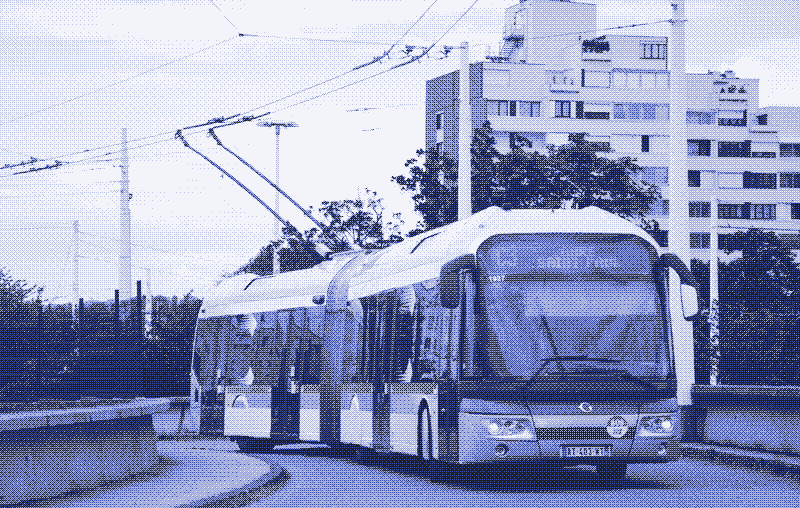
A large-scale introduction of electric cars faces many technological hurdles and promises to be time-consuming and expensive. Greening public transportation and cargo traffic, on the other hand, could be done fast with existing technology for a reasonable price - if we opt for the trolleybus and the trolleytruck.
Cargo traffic and public transport could be electrified in just a few years time.
A trolleybus (or “trackless trolley”) can be defined in two ways; as an electric bus that gets its power from overhead cables, or as a tram (or “street car”) that drives on rubber tyres. Whichever way you look at it, this combination of bus and tram is the most ecological (motorised) means of transport that exists in the world today.
Just like all other electrically powered vehicles (cars, trains, trams) a trolleybus does not produce exhaust fumes, is more efficient than vehicles with a combustion engine, and can drive on renewable energy. The trolleybus, however, has interesting advantages over other electric vehicles.
Cheap, fast, durable
A trolleybus does not need a battery. In this way, it bypasses the weak point of electric cars. Batteries limit the mileage of electric cars, which means that the vehicles require an elaborate infrastructure for fast-charging or swapping batteries. Batteries also make electric vehicles heavy and thus less energy efficient than when hooked up to an overhead line - a battery makes up at least one third of the weight of an electric car.
A trolleybus also has advantages compared to other means of electric public transport. Contrary to a train or a tram, a trolleybus does not need a rail infrastructure. This not only results in huge cost and time savings, it also saves a large amount of energy for building the infrastructure (see for instance this paper: “Environmental assessment of passenger transportation should include infrastructure and supply chains”, pdf). Installing a trolleybus service is of course more expensive than installing a normal bus line, but that extra cost can be recovered because of lower fuel and maintenance costs.
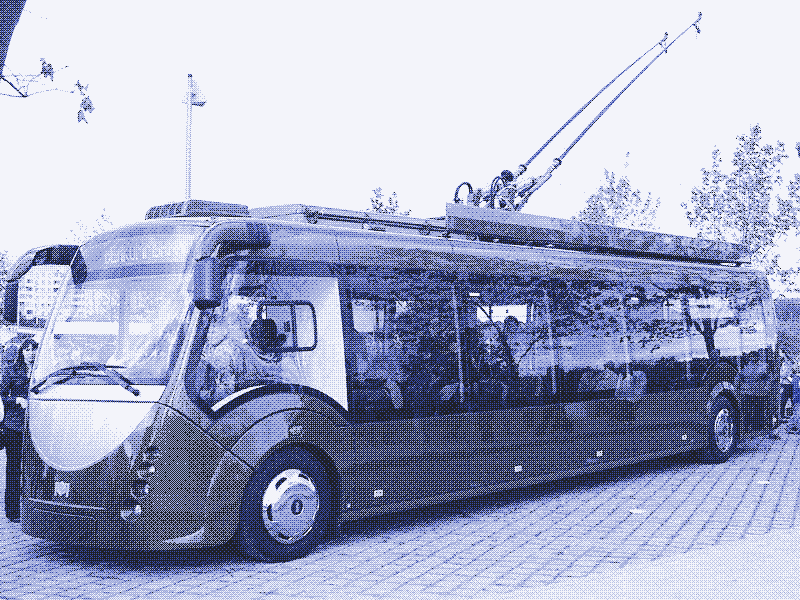
Furthermore, a trolleybus has better braking power than a tram and it is better at climbing hills, since rubber tyres have more grip than steel wheels on steel rails. Trolleybuses are also compatible with bicycles because cyclists cannot get stuck in the tracks. They are more manoeuvrable than trams - a badly parked car will not stop them, because they can diverge from their track for a couple of metres.
Political advantage
Being public transport, trolleybuses of course have the same advantages as trams; they use much less energy and space per passenger than cars. The trolleybus is not only cheap and ecologically sound, it is also fast to implement. There is no need to break up the road, no need to install a charging infrastructure; just attach overhead lines and off you go. This is a political advantage. The announcement and implementation of a system can happen in the same term of service. Because trolleybuses are cheaper than trams, they can also be used on trajectories where a tram would not find sufficient passengers to be cost-effective.
History and evolution
The first trolleybus got hooked up in 1882; the Elektromote, built by Ernst Werner von Siemens. However, it took almost 20 more years before the first commercial line was installed - in Bielatal, close to Dresden in Germany. During the first half of the twentieth century, and especially since the 1930s, the trolleybus was a success story. Around 1950, there were some 900 trolleybus systems operating worldwide. A large share of these was done away with in the 1960s and 1970s, mostly to the advantage of private cars and diesel buses.
Still, in many cities, the trolleybus never disappeared. Today 359 cities worldwide still operate trolleybus lines, the number of buses is estimated at 40,000. Most trolley services are located in the former Soviet Union and Eastern Bloc countries - probably another reason for their lousy image. The 1,300 kilometre network in Moscow is the largest in the world - it has 1,500 buses and 100 lines.
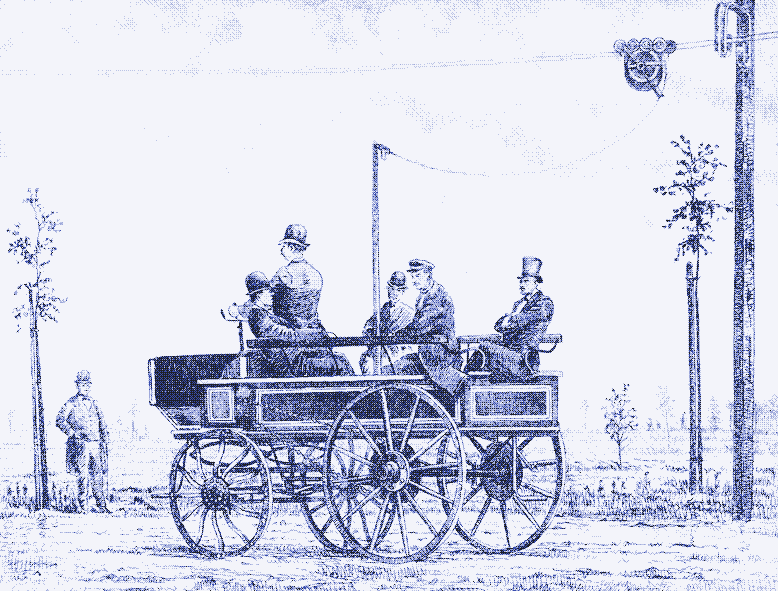
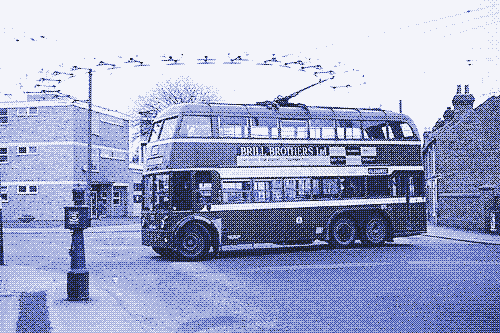
Minsk, the capital of Belarus, has the second largest network in the world with 1,050 buses and 68 lines. Saint Petersburg has the fourth largest network in the world with 735 buses spread across 41 lines (following Beijing, China, in third place). Ukraine has trolleybuses in more than 25 cities and it boasts the longest trolley line in the world: 85 kilometres from Yalta to Simferopol. The three largest networks in the European Union are Athens, Riga and Bucharest. Belgrade, Bratislava, Budapest, Kiev and Sofia are other former Eastern Bloc cities with large trolleybus networks.
Outside Europe
Switzerland has trolleybuses in 13 cities. Dozens of other cities in Europe have smaller networks. Outside Europe there are trolleybus systems in the US (Boston, Cambridge, Philadelphia, Dayton, San Francisco, Seattle), Canada (Vancouver, Edmonton), Central-America (Mexico City, the largest network in the Americas), Latin-America (Argentina, Brazil, Ecuador, Chile) and Asia (China, North-Korea). (sources: 1 / 2 / 3).
Obviously, the technology works, because otherwise it would not have been in service for such a long time in so many places. This cannot be said of electric cars, which all but disappeared in the 1920s.
Inferior technology?
Compared to diesel buses, trolleybuses do have a couple of disadvantages. A trolleybus is more manoeuvrable than a tram, but less so than a diesel bus. If the road is being repaired or rebuilt in a street where trolleybuses pass, chances are that the line has to be discontinued temporarily. A diesel bus can easily be re-routed. Similar to trams, trolleybuses also cannot overtake each other.
The most important drawback of trolley systems is the need for overhead cables. They are generally regarded as ugly and meet protest. Especially at crossroads the cable network can be dense and hard to ignore. Similar to trams, the “tracks” of trolleybuses have points, but the whole mechanism of these hangs in the air. We adore wireless technology and that is probably the reason why trolleybuses are regarded as a ridiculous and inferior technology, a relic from the past.

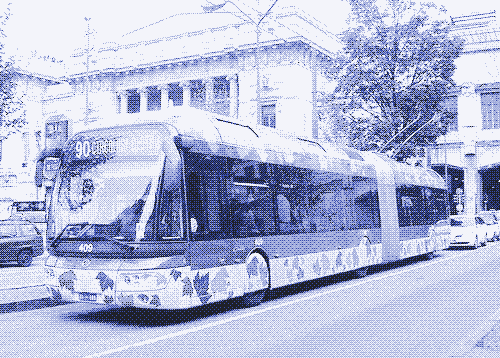
Hybrid trolleybuses provide an answer to most of these disadvantages. By equipping trolleybuses with a battery or an auxiliary diesel motor, the bus can also cover a part of the route without depending on the overhead cables. Most trolleybuses built since 1990 are equipped with at least a small battery or diesel motor for some limited manoeuvring. This can save the installation of overhead cables, especially at turning points and in sheds, where normally a complicated infrastructure is needed to manoeuvre the buses. It can also help to get round road works.
On some lines (like in Boston and Philadelphia) hybrid trolley services exist. The bus then covers part of the route on electricity delivered by the overhead cables, while another part is covered by means of a (larger) battery or a diesel engine. In this way some drawbacks of batteries and diesel engines are introduced, but these disadvantages are limited when compared to electric cars or diesel buses. Hybrid buses might be a way to spare some parts of a city of overhead lines.
New trolleybus lines
Although some cities have recently decided to stop their (modest) trolley services (Ghent in Belgium, Innsbruck in Austria, Marseille in France and Edmonton in Canada), there are many more cities that have recently expanded or modernised their network, re-introduced trolleybuses, or introduced them for the first time.
In France, the trolley lines in Limoges, Saint-Étienne and Lyon (the largest network in France) have recently been expanded and renewed. One line in Nancy (abolished in 1998) will be restored in 2010. In Athens the full fleet of 350 vehicles has been renewed. In Italy trolleybuses have been re-introduced in Rome in 2005 (only one line) and new systems are coming in Lecce, Avellino en Pescara. The system in Bari will be re-opened. A dozen other Italian cities have never abolished their trolley services and do not have any intention of doing so.
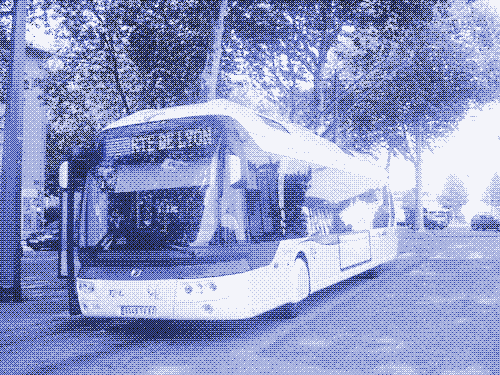
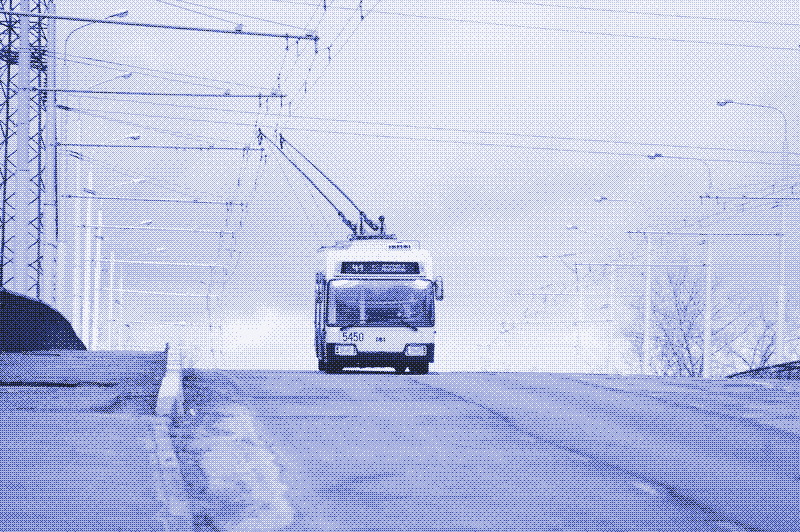
Castellón de la Plana, a city in Spain, re-introduced trolleybuses in 2007, the service was expanded in 2008. In Salzburg (the largest network in Austria with 80 buses and 7 routes) the service was recently expanded. A new system is planned in Leeds in the United Kingdom, which would be the first re-introduction of trolleybuses in the UK in 30 years. Vancouver in Canada renewed its buses in 2007 and 2008, Wellington in New Zealand did the same. Even Ethiopia announced a trolleybus system in 2008.
El Trole
The most spectacular progress is made in South-America. This has everything to do with “El Trole”, the trolleybus network in Quito (below), the capital of Ecuador with 1.6 million inhabitants. The already impressive network, built in 1995, was expanded in 2000 and 2008. On a part of the main line (with a length of 19 kilometres) the trolleybuses make use of exclusive lanes, completely separated from other traffic.
During peak hours, there is a bus every 50 to 90 seconds (because of the high frequency, there are no schedules). El Trole transports 262,000 passengers each day. Five other trolleybus lines connect to it, as well as several other bus lines (including Ecovía, a line similar to El Trole but using diesel buses). The average distance between stops is 400 metres.
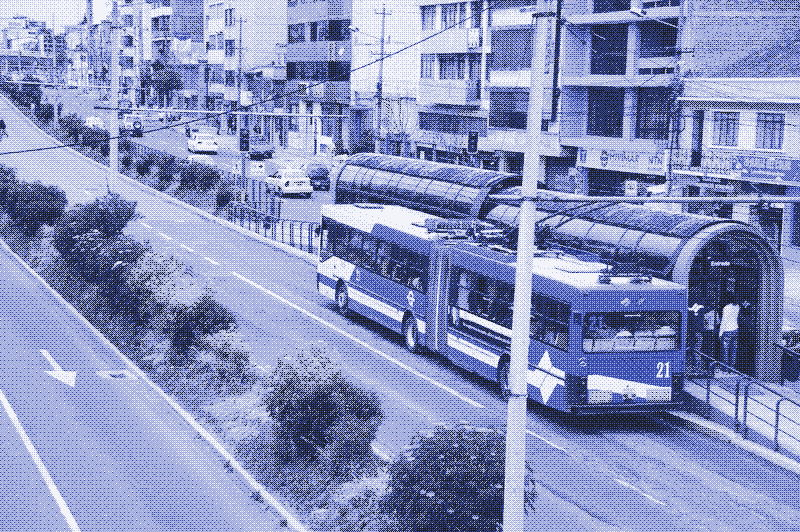
The system in Quito is being copied in Mérida (Venezuela), the first part of that line opened in 2007 (picture below). Other cities in Latin America study the possibility of installing a similar infrastructure, and the Quito system was also the inspiration for the proposals in England and Scotland (second and third picture below).
By choosing the cheaper trolleybus over tram or metro, Quito could develop a much larger network in a shorter time. The capital investment of the 19 kilometre line was less than 60 million dollar - hardly sufficient to build 4 kilometres of tram line (source), or about 1 kilometre of metro line (source). Lower investment costs also mean lower ticket fares, and thus more passengers.
Furthermore, the system is well devised (pdf). There is only one ticket fare, payment happens in the station, not on the bus. Stops are comfortable and built to get fast in and out of the bus, there are very good connections with other lines (sometimes via the same stop), and thanks to the exclusive lanes and (at some crossroads) automatically controlled traffic lights the system is extremely reliable. In Quito, the bus always arrives on time.
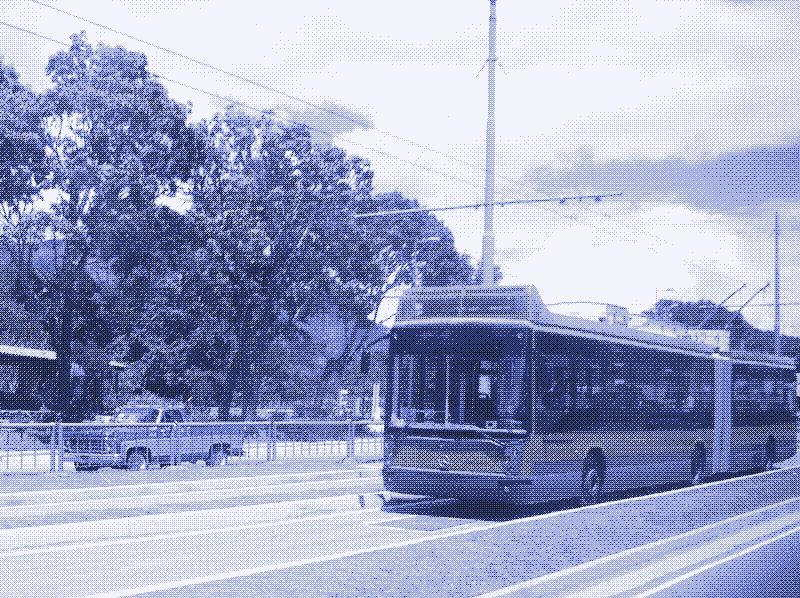
Unfortunately, El Trole has become a victim of its own success. The Ecuadorian government now plans to convert (the larger part of) the main line to a much more expensive light rail line (TRAQ, pdf, in Spanish), arguing that the network is saturated. A protest group consisting of citizens and traffic engineers ("Quito para todos") opposes the 500 - 750 million dollar plan and demands that the money is used to extend of the trolleyline instead:
“The same investment required to build the 20 to 30 km of light rail would build 250 km of exclusive lanes for trolleybuses including vehicles, stations and terminals. Quito’s system of rapid urban mass transport would be complete, providing efficient service, with money left over for construction of bikeways throughout the city, for recovery and integration of public spaces, widening of sidewalks, planting trees and providing urban furniture, building walkways between bus stops and passenger destinations, and other projects to complement the system, in such a way to be able to have a city with an optimal public transport service, placing us in the lead among cities with the best public transport in the world.”
Whatever the outcome in Quito will be, the many advantages of a trolleybus line should not lead to the conclusion that light rail systems are evil or unnecessary. When passenger capacity grows, it can make sense to convert the busiest trolleylines to light rail systems. The income of a popular trolleyline might serve to finance the succeeding rail network. Another compromise: rail-guided trolleys. These vehicles have rubber tyres but are guided by one rail in the middle, which makes it possible to use longer vehicles.
Trolleytrucks
Trolley systems can also be used for the transport of goods. “Trolleytrucks” are a lesser known technology but have an equally long history. Initially, they were as popular as trolleybuses, transporting goods between factories and train stations. Especially the German engineer Max Schiemann put together some remarkable examples in the beginning of the 20th century.
There are more elegant options than trolleytrucks, like underground freight networks. Cost, however, is a serious obstacle.
The technology never really took off, though. Trolleytrucks are still sporadically used in Russia and Ukraine (pictures), and in the mining industry (below, more pictures). However, in the latter case, the electric engine does not replace the diesel engine, but merely assists it.
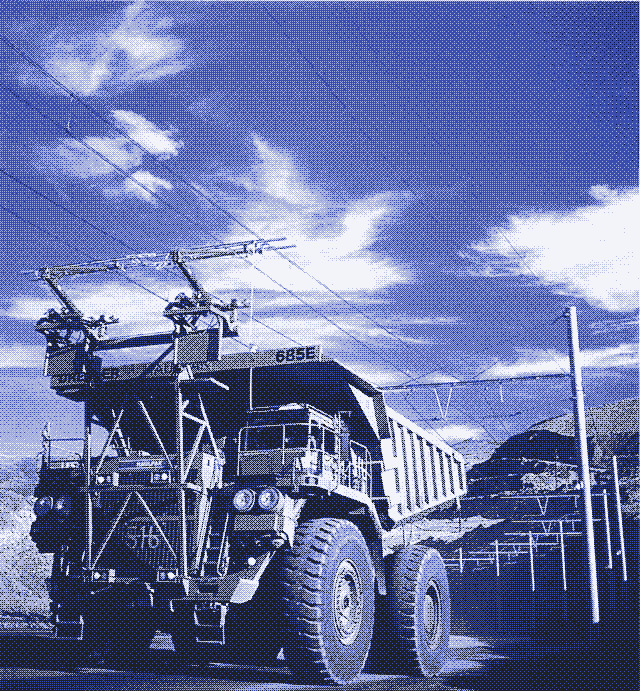
Another historical example is the “Valtellina Dam Project” in Italy (below). These two lines with a total length of 80 kilometres were built in 1936 and remained in service until 1962. Twenty trolleytrucks transported concrete, sand and other construction materials to build two large dams.
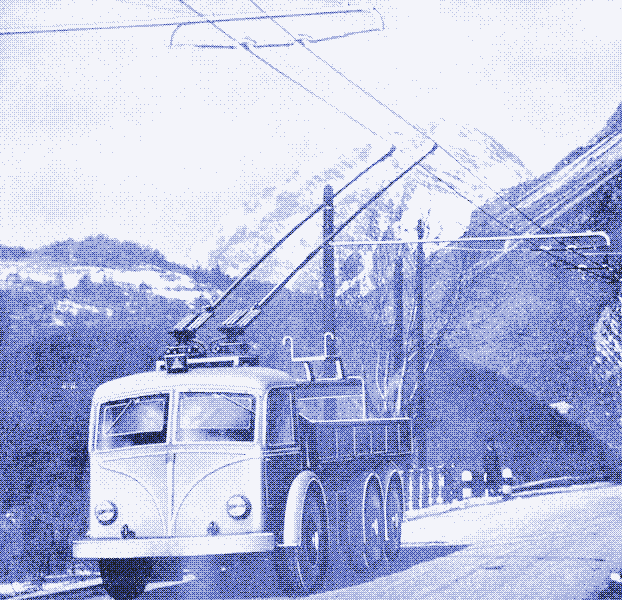
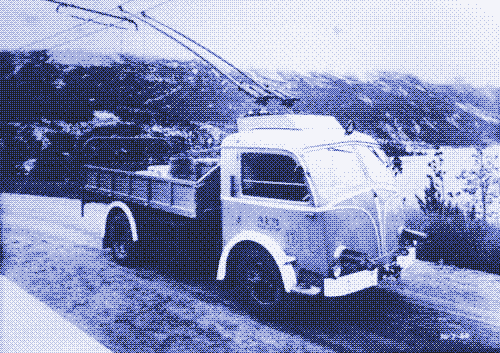
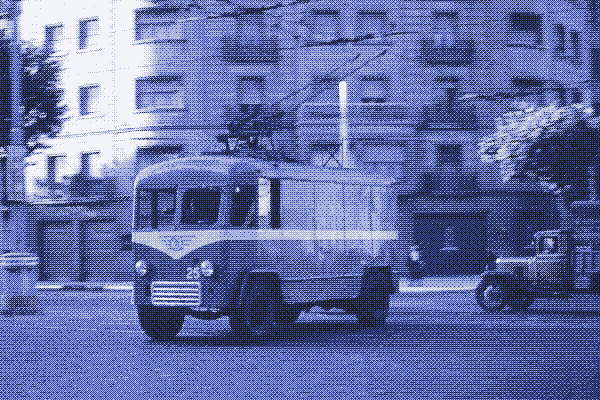
Today there are no cities that plan a trolleytruck system, but the German city of Dresden does have a Cargo Tram (see below, it is also being tested in Amsterdam).
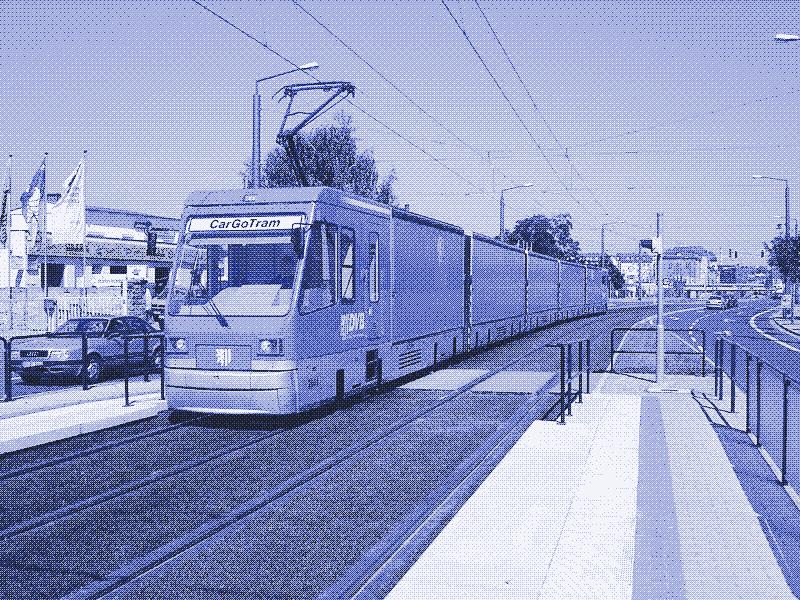
Trolleytrucks and trolleybuses are also put forward as a solution in the 2008 book “Transport Revolutions: moving people and freight without oil”. Authors Richard Gilbert and Anthony Perl propose a plan that would include 500 billion tonne-kilometres of cargo moved by “trolleylorry” in the US by 2025. Trolleytrucks would replace trucks, and complement cargo trains.
High-tech alternatives to trolley systems
There are more elegant options than trolleytrucks, with the same advantages, like the underground freight networks we discussed before. Cost, however, is a serious obstacle. Another alternative for both trolleybuses and trolleytrucks are (wireless) electric buses and trucks, but they too will always be much more expensive, and also less efficient than trolleys - then we are talking about batteries again.
If a bus or truck has a mileage of 100 kilometres, and you have to drive 120 kilometres, you are in trouble. This problem can be solved in two ways. You can put more batteries in your vehicle, but then you increase the cost and the weight and you lower the cargo or passenger space. Or you can set up fast-charging stations or battery swapping stations along the way, but then you increase the costs even more. It gets worse when you start thinking of wirelessly charged buses and trucks. This is a technology that no doubt appeals to more people than trolleybuses do, but it will always be less efficient and more expensive.
All too often we are blind for the costs of high-tech. If we cannot afford a technology, it is of not much use. Low-tech options that have been proven to work can deliver much better results for a bargain. The technology to completely electrify land based transportation has been available for over a hundred years. If we want to, we can do the switchover in just a few years time. Let’s start with public transport and cargo traffic, and then let’s see what to do with cars - if we still need them.
Trolleycars, even though theoretically possible, are not a practical option.
Reactions
To make a comment, please send an e-mail to solar (at) lowtechmagazine (dot) com. Your e-mail address is not used for other purposes, and will be deleted after the comment is published. If you don’t want your real name to be published, sign the e-mail with the name you want to appear.
Reactions
blaise
just a note, but Wellington New Zealand is also a heavy user of the trolleybus. The main challenges here are the tight roads and extreme hills. The electric buses are run on most of the most popular routes and interestingly enough, seem to last a lot longer than conventional buses (there’s still trolleybuses here that look like they were built in the early 70s)
Myrtone
“A trolleybus also has advantages compared to other means of electric public transport. Contrary to a train or a tram, a trolleybus does not need a rail infrastructure. This not only results in huge cost and time savings, it also saves a large amount of energy…”
Are trolleybusses really cheaper than trams when all the factors (including operating life and running costs) are taken into account. How much are the cost saving from not needing rail offset by the extra cost of trolleybus wiring. For trams and train, only and single wire is required per track. Trolleybusses require a pair of wires per direction and thus double the length of wiring per mile. Which means that trolleybuss wiring is usually thicker to compensate for extra losses. Additionally, they often need additional pairs of wires for a moving vehicle to pass a stationary one.
“Installing a trolleybus service is of course more expensive than installing a normal bus line, but that extra cost can be recovered because of lower fuel and maintenance costs.”
Same with electric railed traction, because of even lower fuel and maintenace costs. Steel on steel traction is more efficient than rubber on concrete and steel wheels also last longer than rubber tyres and when finally worn out can be melted down and recycled to make new ones. Rubber tyres are like plastic bags by comparison.
A trolleybus might not need rail infrastructure but does need roads, which need to be paved, and need periodic resurfacing with petrochemical products.
Kelly
Having lived in both Boston and San Francisco, and depended on trolley-buses for transport, I can say that one limitation not listed here is weather. In borderline freezing wet weather, as we often encountered in Boston, the overhead wires ice over and become unusable. “Bus bunching” is also a problem, although a surmountable one. In San Francisco, where MUNI made a huge effort to correct bunching (after the administration shake-up in the mid/late 90s), the fact that the buses could not pass each other became a somewhat moot point. In Boston, where the T made very little effort (or an underfunded effort) to control bunching, this was a HUGE problem. So there is some part of the efficiency of this technology that is dependent on the political and financial resources of the transit agency to manage the limitations of this technology.
Alan Drake/AlanfromBigEasy
Just a couple of quick comments on why trolley buses are NOT the way to go (except in special cases). Streetcars and Light Rail are.
Trolley buses use about 5x the electricity/passenger
The article implies that streets are a free good. Ask a Public Works engineer and you will find that city streets with bus routes require many times more maintenance than parallel streets w/o bus routes. In New Orlaans, almost all bus stops have concrete pads becasue of the wear from buses. Rail tracks last much longer, with lower maintenance. Much lower life cycle costs.
Trolley buses increase ridership by about 3% over diesel buses (quieter & smoother, but still a bus). Streetcars & Light Rail increase ridership 30%, 50% to 100+% over the buses they replace.
Buses (any type) do not encourage Transit Orientated Development in developed nations. Urban Rail does.
The French plan to build 1,500 km of new tram lines in the next decade for 22 billion euros (rubber tired trams in the HQ city of Michelin). Nothing AFAIK on new trolley buses.
The USA should do at least as much/per capita.
Also, the French can go from a “hand wave” (build a tram from here to there) to ribbon cutting in four years.
Best Hopes for Working with the speed & efficiency of French bureaucrats,
Alan
kris de decker
@ Alan & Myrtone:
You make good points concerning the advantages of rail transport. More than a competitor for the tram, however, I see the trolley as a substitute for cars, trucks and diesel buses.
As stated in the article, a popular trolleybus line, built fast and cheap, could pave the way for a later tramway. What is interesting about trolley vehicles is that they allow to electrify transport for a bargain. Of course trams are a better option, but they are also much more expensive. Someone has to pay the bill.
Anyway, whatever you build, the space required should be taken away from cars.
kdd
Thanks to reader Sava from Sofia for teaching me the difference between the former Soviet Union and the former Eastern Bloc. Mistake is corrected.
Irvine Bell
Regarding Alan Drake’s Post: -
Point 1) that trolleybuses use about 5 times the electricity/passenger is wrong. If one compares a 55 tonne tram carrying 250 passengers with a 27 tonne trolleybus carrying 155 passengers, the energy consumption per passenger is about the same. The trolleybus has higher friction losses (rolling resistance) per passenger (around 43%) but lower inertia losses (around 26%). In urban stop start operation where inertia (starting/accelerating/stopping) losses are a substantial proportion of total energy consumption) and even with a reasonable level of regeneration (30%), the trolleybus and the tram net out at about the same energy consumption per passenger.
Point 3) that trolleybuses increase ridership by about 3% over diesel while trams increase ridership 30% or more is simply not comparing like for like. Documented cases of like for like bus to trolley and trolley to bus conversions suggest that trolleys attract 10 to 20% more passengers in the short term. European (cities like Arnhem and Salzburg) trolleybus operating experience suggests that the gains over the long term are larger. New tram/light rail systems with a high degree of segregation providing vast improvements in service quality over street bound buses can show large increases in ridership – but so do comparable bus rapid transit schemes. Basically passengers don’t really care that much whether a public transit vehicle has steel or rubber tyres or even how it is powered. It is the overall service quality – things like average speed, frequency and reliability, along with perceived cost – that determines passenger behaviour. Anybody claiming large increases for a particular mode per se, is being disingenuous.
BUT9711T
Trolley buses are a great mode of transport and heres to all the efforts to bring them back. Diesel buses are like vibrating sardine cans…utterly unpleasant to travel in so hopefully the transport boffins get their arses into gear and bring trolley buses back ASAP!
New Zealand had trolley buses in all main centers. All the buses were english export trolley bus chassis. The most extensive network was DUnedin where at one stage the Trolleys outnumbered the diesEls by two to one. Sadly the short sightedness of local authority leadership saw the closure of most these systems by the 1980/s Auckland brought itself a brand new trolley bus system in 1980, then a change of council saw the whole system wires and all sold at not even a fraction of its purchase price, the wires to the scrap merchants, the Ansaldo buses to Wellington. Apparently some protesters with nothing better to do moaned about the unightly wires. What kind of idiot pre tell goes around all day staring at the wires. Answer only a fucken moron does. No one with a real life gives two stuffs. Alas Wellington now has the only trolley bus system in New Zealand, and, Foxton. Interestingly wellington is the culture capital of NZ also, and has a good range of old buildings preserved that complement the trolley bus system.
Just for the record…..Auckland had extra width trolley buses…Known as RETB 1/2’s, they were mainly lEYLAND BUT cHASSIS, EXCEPT FOR THE FIRST FOUR TROLLEY BUSES WHICH WERE lEYLAND tB4 cHASSIS, and the first mainline trolleys, the BUT 9711T’s were a product of AEC. Christchurch opted for English Electric and Ransomes trolley buses for its sole Line, whilst New Plymouth had Crossley Transits. Dunedin and Wellington went for the standard british export trolley bus of the 50’s, the RETB 1 from Leyland. In the eighties Wellington saved its trolley bus system and went for Volvo Trolleys with Brown Bovery Electrical Equipment whilst Auckland went for the interesting ANSALDO trolley buses that had electronic and electro mechanical equipment. The buses for Auckland never saw service in Auckland and were sold off to Wellington.
Walt
Instead of overhead lines it makes more sense (on highways) to have hot spots and smart cars/trucks.
The vehicles would transpond (RFID like) an id and how much energy they need.
Wheeled Electrodes would drop down and contact the hot spots. The hot spots would be enabled (a transaction) and the jolt given to the vehicle.
The vehicle would store the power in a gyro or a super cap or something until the next hot spot. The hot spots could vibrate or be heated to brake ice etc…
Hot spots would only have power when the conversation with the vehicle has activated that particular spot for a short contact instant.
It could be done now ….
It would be relatively painless.
Radek
I just want to add that we have been using trolleybusses for many years here in Poland. They are quiet, good and have poven its worthness for everyday use in any temperature ect. here are some pictures: http://www.pktgdynia.pl/pages/galeria_tabor.php
Mehul Kamdar
I have heard from a very good friend that Sweden is considering installing new tram systems in cities like Stockholm, Gothenburg etc. Perhaps, you should send them your opinions on trolleybuses as an alternative option - they do have one of the most progressive governments in the world and are happy to listen to informed opinion. Also, knowing the Swedes and their engineering abilities, I would not be surprised if they design a new and improved trolleybus system that could sell to other parts of the world as well.
Transit Jeff
http://www.telegraph.co.uk/news/uknews/road-and-rail-transport/6447960/Trolleybuses-set-to-return-to-Britain-after-40-years.html
Click on the link above to read an article {including video} that states electric trackless trolleys are coming back to Britain after 40 years.
david e.
I live in the once-prosperous city of Dayton, Ohio, where for over 100 years we’ve had an excellent trolley-bus system. Over the decades there have been a number of times when the city considered replacement by other technology, but, fortunately it has been resisted.
Geoff
I live in Wellington and when I’m not biking I catch the trolley bus that goes past my house. They’re fantastic machines - smooth acceleration, much quieter than the diesels (so I can listen to music at sane volumes) and no emissions (from the bus itself, anyway). It also means that there a much less fumes in town than there would be if the whole bus fleet was diesel, which is great from a cycling point of view.
Per Ranch
For your information, a link to a current trolley lorry / trolley truck project in Sweden is enclosed; http://www.elvag.com. Comments and suggestions welcomed! With best regards
Doran
Edmonton has discontinued its trolleybus service in 2009 citing high capital costs for new trolleybuses. Although the trolleys haven’t operated since May 2009, they still have not yet taken down the overhead wires.
http://en.wikipedia.org/wiki/Edmonton_Transit_System#Trolleybus_system
http://stephenrees.wordpress.com/2008/06/19/edmonton-to-scrap-their-trolleybus-system/
David
I remember the trolley Buses here in Bradford, West Yorkshire, UK. They were the last in the UK and it just happened that I worked at the end of the last route. Probably the factory where their motors had been made - English Electric, then GEC now no more.
They certainly accelerated better than IC buses. Trouble was the infrastructure was getting old. Achild being killed by a bit flying off one did not help.
The Trolley Bus Museum in North Lincolnshire is worth a visit. Their collection includes old buses from the UK, Canada and Europe.
I now live near Keighley and found that they to had a trolley bus system in the 1920s. At first they did not use two poles but had a four wheeled trolley running on the supply wires. Only thing it had over the pole system was the wires were closer together so it looked neater.
Martin
This article brought back a memory from the mid ‘50’s in Portland, Oregon. At that time, Portland’s public transit system was privately owned and included a number of trolley-bus lines, one of which ran past the high school I attended at the time. A favorite trick among the cognoscenti was to walk behind the trolley bus when it was stopped to load/unload and yank down on the trolley cables, thus disengaging the trolley from the power lines. A great Yuk was enjoyed by all except the driver.
Myrtonos
Trolleycars, even though theoretically possible, are not a practical option.
But modern trolleybusses do have batteries for off-wire driving so are not limited to their wires. This means they can drive both under the wires and away from them, if buses can do this, surely cars can as well.
Luc Rolland
Istanbul has installed a series of dedicated lanes on major boulevards crossing through the huge metropolis. These lanes are located in the street center where cars cannot go. They have their Metrobuses rolling at very high speeds and rates. These are using nice and modern trolley buses. They even have recently inaugurated a three wagon trolleybus.
Jorge Luis Guevara
El mundo está regresando al trolebús, por ello paises el primer mundo están ampliando sus líneas y renovando sus unidades Los trolebuses modernos están equipados para desviarse de su recorrido y circular fuera del tendido de manera permanente
Paises como Arabia y Venezuela donde su economía se sustenta en el petroleo están instalando sistemas de trolebuses
Abhishek Patil
Can anyone tell me what is the per kilometer energy consumed by a trolley bus?
xorx
Hi,
In Barcelona (Spain) they are considering joining the tram above Frances Macià square with the one below Glories square. They have two options: tram or electric bus. It would be nice if they consider trolleybus too! But do you know who is performing better from a per life cycle basis?